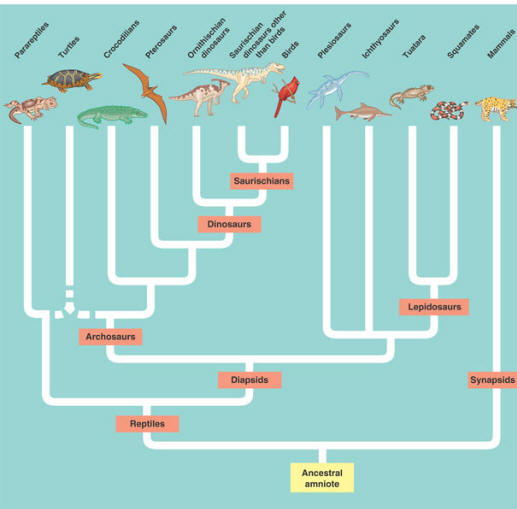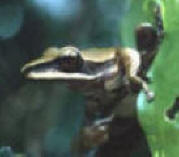
Biodiversity Tour
Week 1 - Thursday
News Item: http://www.durangoherald.com/article/20110901/NEWS06/709019977/-1/News06/We-thought-wed-seen-it-all
http://news.bbc.co.uk/2/hi/science/nature/8338880.stm
Announcements:
Send a representative to the front to collect your folders, or to get a folder for any who missed out last time!
GROUPS: Time to choose a Conservationally & Biologically Appropriate NAME!! (for your group) Then each group member needs to color their folder tab the same color - so your group's folders are color-coordinated.
During class, make sure you are taking "field notes": if we are working on an activity, be jotting down pertinent notes as you go. You can augment these later from the online class meeting outlines &/or powerpoints. When I give a "mini-lecture," you should of course be taking copious notes!
Questions about the syllabus?
Supplies for the class
Long-term assignments for the semester - REVIEW - any questions?
Postings of upcoming lectures & events for Assignment 1
Question 1 - How do we organize Biological Diversity?
What are the 3 levels of biological diversity? consult with your group...
What are the 3 levels of biological diversity?
Genetic Diversity
Species Diversity
Community or Habitat Diversity
We use a Taxonomic Hierarchy:
![]()


3 Domains:
Bacteria (prokaryotic cells - no nucleus or other organelles; DNA is free in the cell)
Archaea (prokaryotic cells - no nucleus or other organelles; DNA is free in the cell)
Eukarya (eukaryotic cells - nucleus & other organelles present; DNA is packaged inside nucleus; cells are much larger)
Within each Domain are several Kingdoms (follow the link above to the UC Berkeley website to learn more!)
The Kingdoms we are most familiar with, those from the Domain Eukarya, are shown above:
The Protozoa (actually several kingdoms, but still usually treated as one very large, diverse group) - includes single celled organisms with eukaryotic cells
The Chromista - includes the algae (like kelp, or Nori, or many others)
The Plant Kingdom
The Fungi Kingdom
The Animal Kingdom
![]() The levels of the taxonomic
hierarchy:
The levels of the taxonomic
hierarchy:
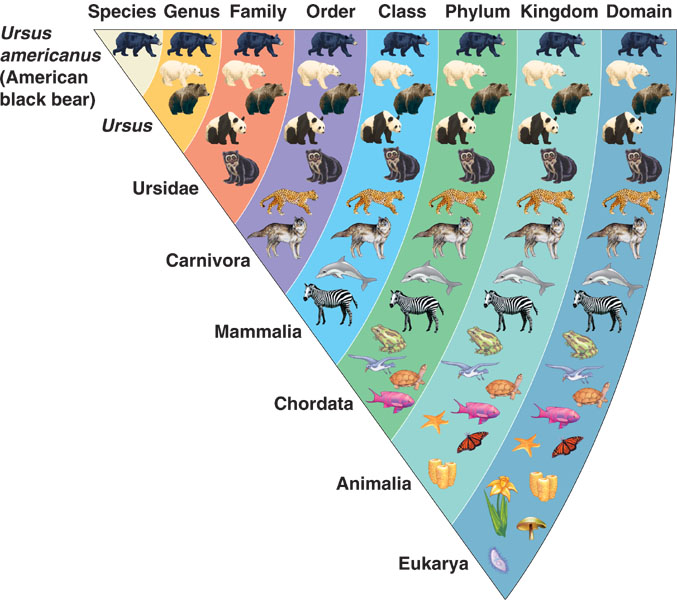
Question 2 - What are some examples of Biological Diversity from different levels of the taxonomic hierarchy?
Examples of organisms from the various Domains or Kingdoms & Phyla:
Domain Bacteria:
Bacteria are a major group of micro-organisms that live in soil, water,
plants, organic matter, or the bodies of animals or people. They are microscopic
and mostly unicellular, with a relatively simple cell structure.
Some bacteria cause diseases such as tetanus, typhoid fever, pneumonia,
syphilis, cholera, and tuberculosis.
Bacteria play a role in the decomposition of organic matter and other chemical
processes.
www.greenfacts.org/

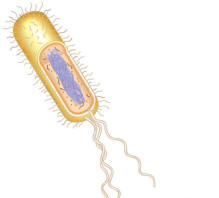
Example: Escherichia coli bacteria
A typical Prokaryotic cell
Domain Archaea
The scientific community was understandably shocked in the late 1970s by the discovery of an entirely new group of organisms -- the Archaea. Dr. Carl Woese and his colleagues at the University of Illinois were studying relationships among the prokaryotes using DNA sequences, and found that there were two distinctly different groups. Those "bacteria" that lived at high temperatures or produced methane clustered together as a group well away from the usual bacteria and the eukaryotes. Because of this vast difference in genetic makeup, Woese proposed that life be divided into three domains: Eukaryota, Eubacteria, and Archaebacteria. He later decided that the term Archaebacteria was a misnomer, and shortened it to Archaea. The three domains are shown in the illustration above at right, which illustrates also that each group is very different from the others.
Further work has revealed additional surprises, which you can read about on
the other pages of this exhibit. It is true that most archaeans don't look that
different from bacteria under the microscope, and that the extreme conditions
under which many species live has made them difficult to culture, so their
unique place among living organisms long went unrecognized. However,
biochemically and genetically, they are as different from bacteria as you are.
Although many books and articles still refer to them as "Archaebacteria", that
term has been abandoned because they aren't bacteria -- they're Archaea.
http://www.ucmp.berkeley.edu/archaea/archaea.html

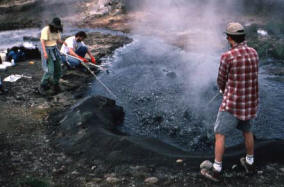
Finding Archaea : The hot springs of Yellowstone National
Park, USA, were among the first places Archaea were discovered. At left is
Octopus Spring, and at right is Obsidian Pool. Each pool has slightly different
mineral content, temperature, salinity, etc., so different pools may contain
different communities of archaeans and other microbes. The biologists pictured
above are immersing microscope slides in the boiling pool onto which some
archaeans might be captured for study.
Domain Eukarya
The Eukaryota include the organisms that most people are most familiar with - all animals, plants, fungi, and protists. They also include the vast majority of the organisms that paleontologists work with (i.e. fossil life-forms). Although they show unbelievable diversity in form, they share fundamental characteristics of cellular organization, biochemistry, and molecular biology. The diagram below shows the parts of a typical eukaryotic animal cell.
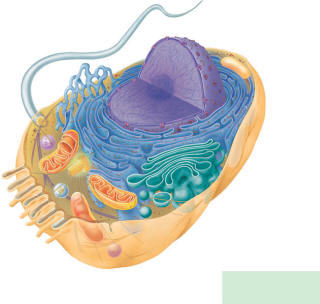
The FIVE kingdoms of the Eukarya are represented in the figure below.

The Kingdoms of Eukaryotes:
Chromista - Algae; photosynthesizers
Example:
Single-celled algae, such as
Diatoms


The richest sources of diatom fossils are deposits of their skeletons known as diatomite, or diatomaceous earth. This mineral was formed as ancient diatoms died and settled to the bottom of lakes or oceans. Today, they form large deposits of white chalky material, which is mined for use in cleansers, paints, filtering agents, and abrasives. Many toothpastes contain bits of fossil diatoms! http://www.ucmp.berkeley.edu/chromista/diatoms/diatomfr.html
![]() Question
3 - What are some examples of Biological Diversity that we can see here on
campus??
Question
3 - What are some examples of Biological Diversity that we can see here on
campus??
Be able to give local examples - that you have seen- of some of the groups listed below (we will not see any sea sponges or jellyfish...!).
Plant Kingdom
Major Groups (include 10 Phyla):
Bryophytes (3 phyla: mosses, liverworts, hornworts)
Pteridophytes (2 phyla: lycopodia, ferns & allies)
Gymnosperms (4 phyla: ginkgo, cycad, gnetophytes & conifers)
Anigiosperms (1 phylum: flowering plants)
(2 main classes: Monocots & Dicots)
Kingdom Fungi
4 Phyla:
aquatic Chytrids
Zygote fungi (bread mold, hairy mold on fruit, many mycorrhizae)
Ascomycetes Sac or Cup Fungi (morels, truffles, yeasts, penicillin, with
algae form lichens; plant pathogens)
Basidiomycetes Club Fungi (mushrooms, shelf fungi, puffballs,
rusts; wood rotters; plant parasites (rusts & smuts))
Animal Kingdom
Invertebrates (many phyla):
Sponges (Porifera)
Cnidaria (sea anemones, jellies, coral polyps)
Flatworms (Platyhelminthes e.g. tapeworms!)
Mollusca (snails, slugs, oysters, clams, octopus & squid)
Annelids (segmented worms earth worms, leeches)
Nematods (roundworms; soil decomposers, root pests; animal
parasites e.g. worm causes trichonosis)
Arthropods 4 Phyla (exoskeletons & jointed appendages)
Trilobites
Chelicerates (spiders, scorpions, horseshoe crabs)
Uniramians (centipedes, millipedes, insects)
Crustaceans (crabs, lobsters, shrimps, barnacles, etc.)
Echinoderms (sea stars, sea urchins, sand dollars)
Vertebrates (1 phylum):
Chordata
Many Classes:
Hagfish & Lampreys
Sharks & Rays (cartilaginous fish)
Bony fishes
Amphibians (frogs, salamanders, legless caecilians)
Reptiles = several classes (turtles, lizards & snakes, crocodiles
& alligators)
Mammals
Birds - how are birds related to dinosaurs? See the "family tree" below for one of the current
ideas...!
